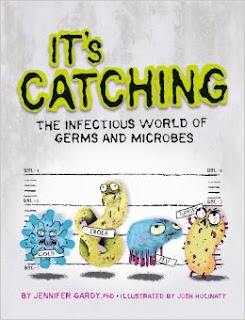I love reading Science books, especially those written for
kids. That's because authors have to know a lot about their topic in order to
distill the information into interesting and understandable communications that appeal to
young readers. In the following titles, Jennifer Gardy and Tanya Lloyd Kyi make
challenging scientific information readily available to young readers. These
books should be in every elementary school library — and the collections of all teachers
who hope to interest students in modern science.
It's Catching: The
Infectious World of Germs and Microbes written by Jennifer Gardy and
illustrated by Josh Holinaty (Owl Kids, 2014) uses a combination of text,
visuals, and anecdotes to introduce readers to the many germs with which we
share this planet.
The author, herself a disease detective, introduces past
disease detectives, such as Antonie van Leeuwenhoek, the first person to see
the microbial world. She explains that microbes exist both in the world around
us and in our own bodies. Some of the details provide the necessary gross
factor that kids love.
Without boring the reader, Grady outlines the difference
between viruses, bacteria, fungi, and parasites. There's also a dangermeter for
diseases that range from the common cold and influenza to malaria and ebola.
Discussing why doctors are so worried about parents who
don't have their kids vaccinated against measles? Mention the 165 BCE measles plague
that killed off about one-third of Rome's population. Have students of Irish descent?
Suggest researching family trees to find out how many have ancestors who came
to Canada following the 1845 Irish potato blight.
DNA Detective by
Tanya Lloyd Kyi and illustrated by Lil Crump (Annick Press, 2015) is equally
interesting. The intro draws kids right into the topic by showing a crime
scene. Someone broke into a jewellery store and got away with valuable jewels.
The perpetrator wore gloves. One was left at the scene. There are no other
clues.
Readers will enjoy trying to pick the culprit from a list of
suspects who include the store's manager, bookkeeper, custodian, and two
cashiers, as well as three customers (two of them identical twin supermodels), a sales rep, a security guard, the owner of the store next door, and a convicted thief. They can follow the thinking processes of a young detective on her first case
as she collects DNA evidence in an effort to identify the culprit.
The author compares DNA identification to a high-tech fingerprint. Both can be inadvertently left behind and collected from crime scenes. The book includes profiles of past DNA rock stars, such as Gregor Mendel and Rosalind Franklin. A cartoon page or spread at the end of each section brings readers back to the crime in question. The detective outlines what she's learned. In most cases, readers can use this information to eliminate suspects. By the end, the detective — and readers — have their man — er, woman.
Books such as these provide excellent introductions to
topics kids will continue to learn about throughout their student years — and
likely their entire lives.



No comments:
Post a Comment